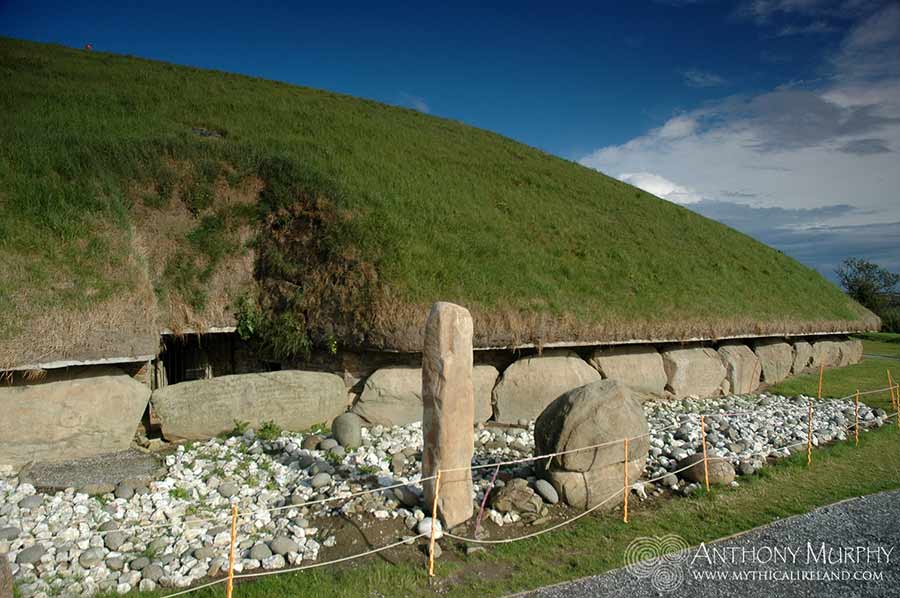This is a beautiful and yet heartbreaking insight into a possible meaning of the "nut lamentation" which is one of the stories from the Dindshenchas about how the great passage-tomb of Knowth got its name. It was contributed to the Irish-Stones group by Helen McKay.
In the time the Brú was built, the sun rose in Taurus at the spring equinox. While we're not sure of how the Celts viewed the star stories, this important part of the sky is consistently a bull. And the word for the bull's crescent horns to this day is 'benn' (as in Finbennach, the white horned bull). The whole Brú complex sits on what is called a benn-chor, a curve of the river in the crescent shape, hence all the monasteries that end up as Banchory, etc. The bull is ever a symbol of male fertility - and the moon, so the central notion of the male bull-moon mating with the female sun at the spring equinox is a great picture.

But it gets better, because when you have a big central myth like this, lots of other things and ideas are going to get attached to the story. One thing that gets attached is the three cranes, that pop up all through Irish mythology and continental carvings - of Esus. I'm sure most people here will have seen this picture too, the great Donnotaurus (the Brown Bull of Ulster) and his local bull, sitting in the paddock with stunning white egrets perched on his back. But it's these cranes that are so fascinating, and without writing a book here, everywhere you go, in Ireland, in western civilisation, cranes/egrets are portrayed both as birds that have human souls, and the birds that brings souls into the world to be (re-)born. Most people here will have either received a stork baby card, or sent one at some point in their life. Sometimes a story is so deep in our genes, so intimately connected to our world view, that it can't be shaken off. The most famous of the three cranes of the great bull is Aife, who is cursed to become a crane, and then her skin is used as a bag to hold things for Manannan (notice how many moon gods have names that start with man- or mid-). In the children of Lir story, Aife is again cursed to become a "demon of the air" after turning her sister's children into swans. And what is directly above Taurus where these cranes would sit, but Algol, the demon star, which is a variable star that brightens and dims, just as the crane bag shows its treasures with the ebb and flow of the tide.

Too much really to tell in one small email. But, if we think of the cranes and their role in bringing children into life - at the spring equinox at Knowth, then we have something stunning to consider. And no I don't understand this, but it's a powerful story. Because if you look at the burials in the small mounds surrounding Knowth, and now at the breakdown of the cremation bones within Knowth's chambers, something extraordinary comes up - that there are lots of child cremations. Lots. Children only rarely get cremated, probably they die all too often, and aren't of high enough status to warrant a major ritual. There are children's bones in other tumuli, but only relatively rarely are they cremated. There is another 'urn' field in Ireland where each urn held a child and an adult - as if, said the archaeologist, the child was being given an adult to help them through to the otherworld. But here at Knowth we appear to have children probably being cremated then brought to Knowth for some special reason that only Knowth itself now remembers.

But there is a strange story about Knowth, just as we have the other stories, and it's all about loss (bearing in mind that we also have the western passage for death rituals?) Midir (note moon mid- element; who also owns the cranes) carries off a girl that Angus loves and part of the story is this:
This was the food of his band – bright feast –
blood-red nuts of the wood:
he casts the food from him on the ground;
he makes lamentation around the hillock.
Though it be called the Hill of Bua of combats,
this is the equal-valid counter-tale:
we have found that hence
from that 'nut-wailing' Cnogba is named.
So 'nut-wailing' and burials are what the stories of Knowth are about, and so it is. For a long time I tried to find any native 'blood-red nut' in Ireland, without success. But, when I went to look at the way a 'nut' is used within the language, it is a metaphor for a child. There is a story here at Knowth at the equinoxes that cuts deep into grief and the way people hoped for life renewed for their lost children.

